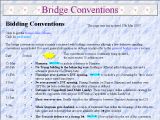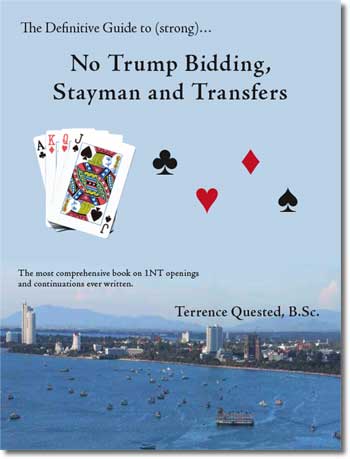Mon 4th N-S 1st Jeremy & Sally 66% 2nd Janne & Jean 65%
E-W 1st Hans V & Per And.. 64% 2nd Gier Helgemo & Rolf A 58%
Wed 6th N-S 1st Gerry C & Sally 61% 2nd Morton & Terje Ly.. 56%
E-W 1st Hans V & Janne 65% 2nd Arne F & Lars F 59%
Fri 8th 1st Janne & Jean 57% 2nd Hans V & Paul Q 55%
| to news-sheet main page |
 |
||||
| to Pattaya Bridge home page |
|||||
 |
to bridge book reviews | to bridge conventions | to No Trump bidding | ||
| to bridge CD's and computer games and software | |||||
Bidding Quiz Standard
American bidding is assumed unless otherwise stated.
Hand A Hand B With Hand A you open 2♣ and partner bids 2♦, what do you
♠
AQ10 ♠ - rebid?
♥ A4 ♥ QJ
♣
KQ ♣ KQ8642
Hand C What do you open in 2nd seat with Hand C?
♠ J96
♥ 5
♦ AKQJ10
♣ J964
.
A big balanced hand Board 4 from Fridayday 8th
Dealer: ♠
8654 Table
A
West ♥ J53 West North East(A) South
Both vul ♦ 63 - - 2♣ pass
♣ 10974 2♦ pass 2NT (1) pass
3NT (2) pass pass (3) pass
♠
J3 N ♠ AQ10
♥ Q10972 W E ♥ A4
Expert Table
♣
A852 ♣ KQ - - 2♣ pass
♠ K972 2♦ pass 2♥ (1) pass
♥
K86 2♠ (4) pass 2NT (5) pass
♦ 1087 6NT (6) all pass
♣ J63
And what happened? 6NT=, 3NT+3 twice, 3NT+2 and 6♥-2.
The bottom line:
-
The sequence 2♣
- 2♦ - 3NT really sucks (as does a strong opening 3NT). There
are numerous way round it. Play Benjamin twos (when 2♦ - 2♥
- 2NT is game forcing); play the multi two diamonds (where 2♣ - 2♦
- 2NT is game forcing) or play the Kokish relay.
Dave’s Column Here is Dave’s first input on the play of the hand.
♠
KQ109754 ♠ 632 - - pass 1♦
♥ 6 ♥
QJ9 pass 1♠ pass 1NT
♦ A6 ♦ QJ102 pass 4♠ all pass
♣ Q94 ♣ AK3
Dave’s
Column answer Board 11 from Wednesday 6th
Dealer: ♠ KQ109754 Book bidding
East ♥ 6 West North East South
Love all ♦ A6 - - pass 1♦
♣ Q94 pass 1♠ pass 1NT
pass 4♠ all pass
♠ 632 trump break (East
discards the ♥8 playing standard
♥
QJ9 discards),
how should declarer play the hand?
♦ QJ102
♣ AK3
What happened when the hand was first played
was that declare r led a ♣ to the ♣K in order to leas another ♠ through West. West won his ♠A and led a ♥ to East’s ♥A so that he could score a ♣ ruff. Could declarer play better?
Yes. After discovering the 3-0 trump break,
instead of returning to dummy with a ♣ This
farsighted play is not as difficult as it may seem. On the first ♣ West had signaled encouragement (the ♣2 if you play low to encourage) and on the
first trump East had signaled for a ♥.
Clearly it was time to cut defensive communications. Regardless of which
defender won the ♥
lead, declarer can prevent East
from giving his partner a ♣ ruff.
And what happened at the Pattaya bridge club? 4♠+1, 4♠=
five times, 1♠+2, 4NT-1 and 4♠-2 twice.
Dave’s 2nd Column Here is Dave’s second input on the play of the hand.
♠
K64 ♠ A85 - - 1♣ pass
♥ QJ1097 ♥ A863 1♥ pass 2♥ pass
♦ AQ7 ♦ K53 4♥ all pass
♣
J4 ♣
K85
You are West, declarer in 4♥. North leads the ♥4. plan the play.
Dave’s 2nd Column answer Board
10 from Wednesday 6th
Dealer: ♠
Q32 Book
Bidding
East ♥ 54 West North East South
Both vul ♦ J642 - - 1♣ pass
♣ 9762 1♥ pass 2♥ pass
4♥ all pass
♠
K64 N ♠
A85
♥ QJ1097 W E ♥ A863
North leads the ♥4. Plan the play.
♣
J4 ♣
K85
♠ J1097
♥
♦ 1098
♣ AQ103
What should West do after north’s passive trump
lead? If he gets greedy and ducks in dummy he loses the timing to make his
game. South wins with the ♥K and shifts to the ♠J; and with South controlling the ♣ suit the defenders can establish a ♠ trick before declarer can build a ♣ winner.
It’s different if declarer wins trick one with
the ♥A. He then leads a low ♣ from dummy, South’s ♣J wins and South switches to a ♠. The ♣J
then drives out South’s ♣A, another ♠ goes to dummy’s ♠A but declarer wins the race as he can discard a ♠ on the ♣K.
Note declarer’s play in ♣’s. Low to the ♣J gives West two chances instead of one. If the ♣J loses to North’s ♣Q he still has time to lead to dummy’s ♣K.
And what happened at the Pattaya bridge club? 5♥-1, 4♥-1
seven times and 4♥= twice.
Paul’s Column
♠ 8
♥ KJ84
♦ 9532
♣ KQ102
Hand C
♠ K1075432 ♠ J96
♥ 102 ♥ 5
♦ 974 ♦ AKQJ10
♣ 3 ♣ J964
♠ AQ
♥ AQ9763
♦ 6
♣ A875
At first glance I didn’t see how South would avoid a club loser, but then it became obvious. First, after North deals and passes, what did you open the East hand C in this week’s quiz? Popular will be 1♦, but when my hand is ALL diamonds and no outside defense I’d personally stick the ♥5 in with the diamonds and open it TWO diamonds! As for making 6♥ it seems like if clubs are 3-2 this is a no-brainer. Accordingly South plays as follows: lose the diamond lead, win the next trick whatever it is, Ace and a spade ruffed after drawing trump, return in trump and FINISH THE TRUMPS! Reduce the South hand to: ♣A875, the North hand to ♦9 ♣KQ10 and what will East hold as his last 4 cards? He can’t allow the ¨9 to become a winner as there is an entry, and he can’t discard a club from ♣J964. A simple squeeze! The hand is an example of the BLUE law of squeezes … one hand must be BUSY in 2 or more suits (guarding them), the LOSER count must be met (declarer has lost all he can), one threat must be UPPER to the “victim” (to the left of) and there must be an ENTRY to the threats. Hence BLUE. There are exceptions to the LOSER requirement in highly specialized cases but they are rare.
Does it cost South anything to play in this fashion rather than test the clubs before finishing the trumps? Not a blessed thing! Testing the clubs first would cost this slam.
Open a 5-carder instead of a 6-cardsr? Board 6 from Friday 8th
♠ VOID A couple of hands from Friday the 8th caught my
attention. Terry was
♥ QJ kibitzing me and questioned my opening bid of 1 diamond with the
♦ AJ765 following hand, board 6, all vulnerable:
♣ KQ8642
He felt that a 1 club opening was better with the hand playing strength being sufficient to bid diamonds later. I clearly felt that if partner responded 1 of a major this was not worth a “Reverse” and I’d be trapped into a 2 club re-bid; furthermore if the partnership plays “Walsh” style responses to 1 club where a diamond suit may be by-passed to name a major with a limited response a diamond fit might be missed altogether. At our table the 1 diamond opening was doubled to my left, partner raised to 3 (limit raise in his style) and after a pass I bid 5 which was doubled. This made exactly for a tie for top when the doubler’s ♠A K proved worthless. Opening a 5-card higher ranking suit in preference to a 6-card lower ranking one is pretty much the norm when you lack 16+ HCP and want to simplify your re-bid. One notable exception many experienced partnerships use is when opener holds 6 clubs and 5 spades with limited strength. Since 1 spade can be re-bid over any 1 level response, and spades re-bid as cheaply as possible later, the nature of the hand is very accurately expressed. Some extend this to 5 GOOD clubs and 5 WEAK spades.
< End of Paul’s column >
Hand A: 3NT or 3♦ I suppose – but I hate them both! It really is necessary to have an
agreement on how to bid these big balanced hands so that a 2NT rebid shows 25+
balanced. Options are to play Benjamin twos, to play the Multi 2♦, or to play the
Kokish relay. 2NT (22-24) is a gross underbid of course with this huge ♦ suit and
use-full-looking ♠10.
The following two are from Paul’s Column and are his opinions:
Hand B: 1♦ is Paul’s answer. A 1♣ opening would lead to problems if partner responds 1♠ as the hand is not
strong enough for a reverse into 2♦.
Hand C: 2♦. When my hand is ALL diamonds and no outside
defense I’d personally open it 2♦ rather than 1♦.


